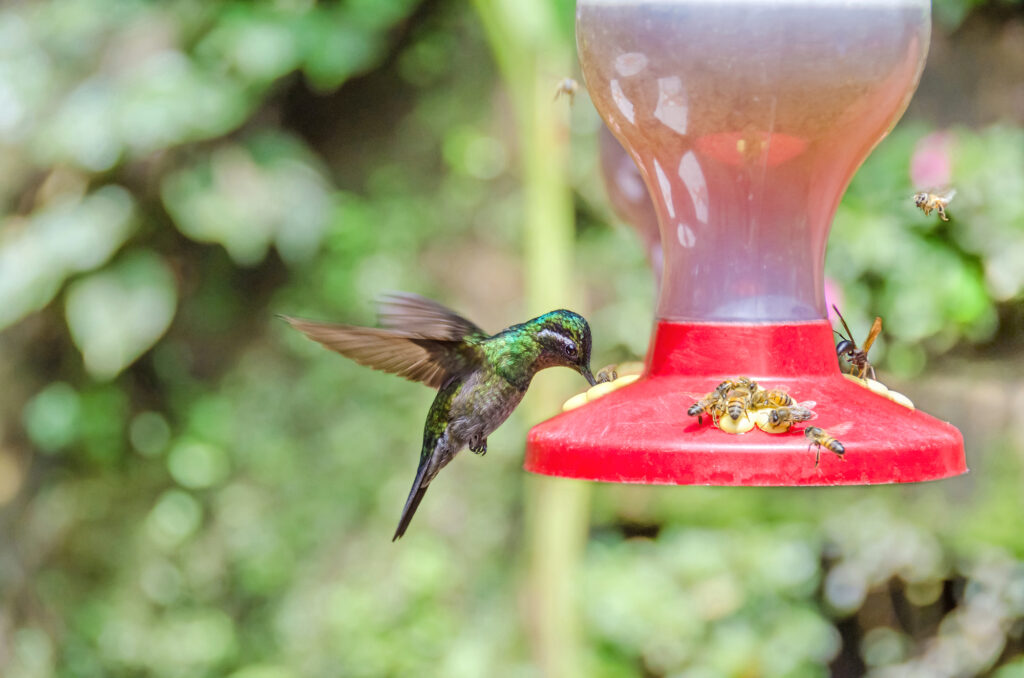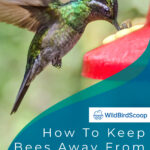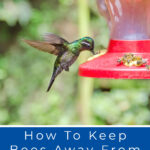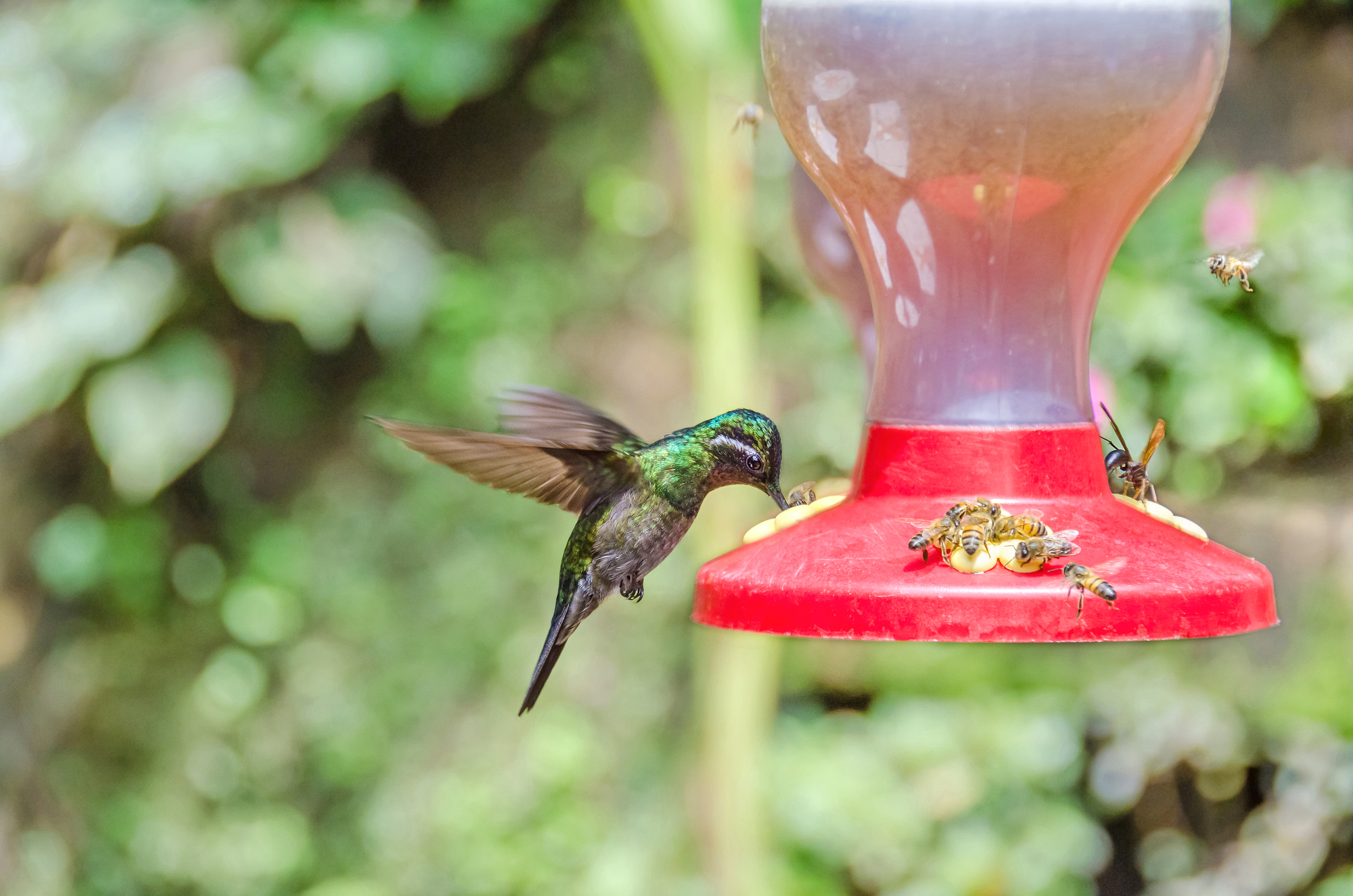In an organic garden, we can often take a live-and-let-live approach, welcoming all the creatures that share our space.
Bees and wasps are crucial pollinators that play an important role in the local ecology, so we should never aim to get rid of these beneficial species entirely.
Nonetheless, their presence in some locations close to human habitation is far from ideal. Apart from the risk of getting stung by these insects, we also want to keep bees and wasps away from the food we put out for the birds.
Let’s discuss how to keep bees away from hummingbird feeders…
Are Bees & Wasps a Problem for Hummingbird Feeders?
Having individual solitary bees and wasps around a hummingbird feeder won’t necessarily be a problem at all.
But if you have swarms of these insects around your feeder, they will of course deplete the levels of the sugar water—meaning less for the hummingbirds you want to attract.
Bees and wasps crowding around a feeder can also contaminate the food source. And the congested conditions mean that hummingbirds will often stay away—seeking less contended food sources.
Are Hummingbirds Afraid of Bees & Wasps?
Hummingbirds are not exactly afraid of bees and wasps.
However, just like we don’t like to battle crowds at the grocery store, hummingbirds also dislike having to compete with crowds around a feeder. They like to be able to get in and out quickly and easily to obtain the nectar they need.
Yellow jackets and other territorial insects, and even swarms of bees, may even fight to retain their positions around a feeder – which, though unlikely to actually harm hummingbirds, will encourage them to stay away.
Can I Keep Unwanted Bees & Wasps Away From Hummingbird Feeders?
The good news is that it’s relatively easy to keep unwanted bees and wasps away from hummingbird feeders so that you can preserve the meal for the birds that need it.
There are several all-natural solutions in an organic garden that will allow you to welcome these creatures into your garden while making sure supply doesn’t become an issue.
How Do I Keep Bees & Wasps Away From My Bird Feeder?
Make Sure There Is Nectar for All in Your Garden
The first and most important thing to do if you want to keep bees and wasps away from feeders is to make sure there are abundant natural food sources, for all pollinators.
Provide plenty of natural nectar sources for bees and wasps and they won’t be as likely to seek out food in the places they shouldn’t.
Plant flowers with varied bloom times in native flower gardens. If gardens have plenty of nectar-filled flowers, bees and wasps will be able to find an alternative food source, and will be less likely to gravitate to your hummingbird feeders.
Choose the Right Types of Hummingbird Feeders
When choosing hummingbird sugar-water feeders, looking at different feeder designs can be key.
Placing your sugar water ‘nectar’ in saucer feeders rather than inverted hummingbird feeders is the best way to ensure that the birds can access it while bees and wasps cannot.
Feeder holes can be adapted to make sure that the feeder meets the needs of hummingbirds without providing easy access for unwanted visitors that are also attracted to the sweetness within.
Another thing to consider is that a red feeder will attract hummingbirds without enticing other pollinators.
If you avoid bee-attracting colors, like the color yellow, the feeders are less likely to come to the attention of bees.
You might also consider changing the sugar ratio inside your hummingbird feeders. The ratio of sugar to water can be reduced from 1:3 or 1:4 to 1:5 to lessen the appeal of the fluid for visitors other than the birds.
Add Bee Guards to an Existing Feeder
If you already have a feeder, you might adapt it by adding bee guards to prevent bees and wasps from taking over, or to encourage your unwelcome guests to look elsewhere for food.
Like ant moats, these are adaptations that can ensure that feeders provide a meal for hummingbirds, and hummingbirds alone.
Place a Feeder Correctly
Place a feeder in light, dappled, or partial shade rather than in the full sun. Feeders in full sun may be damaged in the heat of summer, and damaged feeders are more likely to attract unwanted guests.
Prevent Leaks and Keep Your Feeder Clean
Make sure that you always keep your hummingbird feeder clean and check it regularly to make sure that it is leak-free. Sweet nectar spilling out all over the place will more likely cause pest problems.
How Do You Get Rid of Bees & Wasps Without Harming Hummingbirds?
Move Feeders Around
If a swarm of bees or wasps has found your feeder, simply moving it to a new location within your garden may help. Insects may move on, but hummingbirds should still be able to find a feeder when it is relocated close by.
Place Fake Wasps Nests as an Effective Deterrent
Since some wasps are territorial, placing fake wasps nests near a feeder may lead them to believe that the territory has already been claimed, and could discourage them from setting up shop in the area.












